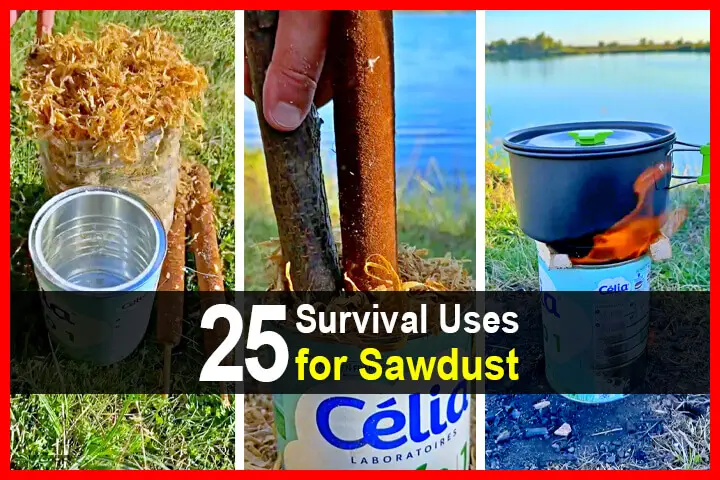Estimated reading time: 12 minutes
If you or someone you know has a big woodworking project in their future, it’s a good time to plan for saving the sawdust. These small chippings of wood that are left over after sawing, milling, planing, sanding, and routing have many uses around the home and garden.
However, before we get into a list of many of those uses, here are a few words of caution. First, use sawdust from untreated raw wood. Cedar, ash, cherry, oak, fir, and many fruit trees are safe to use.
Fresh sawdust from black walnut trees contains juglone, a chemical that is toxic to some plants. Black walnut sawdust becomes safe to use after about six months.
Now on to our list of uses for sawdust.
Want to save this post for later? Click Here to Pin It On Pinterest!
1. Absorbing spills

When you have a liquid mess in the home, garage, or barn, sawdust is excellent at absorbing spills. All you need to do is sprinkle sawdust on the liquid, wait about 20 to 30 minutes for it to congeal, and then sweep up and dispose of the material.
2. Creating fire starters

Like the wood it comes from, sawdust is flammable. That makes it suitable for use as a fire starter. Add compressed sawdust to paper muffin liners, small paper cups, or cardboard egg cartons. Then, melt candle wax over each section.
Here’s a video that shows the process. You can also compress sawdust into cubes to use as fire bricks in your fireplace or stove.
3. Fertilizing plants

You can use sawdust in your garden and pots as a type of slow-release fertilizer.
Sawdust helps boost the soil’s organic matter content, allowing plants to absorb and use essential nutrients like nitrogen more readily. Sprinkle it lightly around your plants.
4. Mulching your garden

A related use to the one above is that sawdust works well as a garden mulch, helping to prevent weeds and retain moisture. Sawdust decomposes more slowly than commercial mulch. You may find that one layer lasts the entire gardening season.
5. Preventing slips and falls

Unlike some of the ice-melting products sold in stores that can hurt plants and animals, sawdust can provide a safe anti-slip surface. Just be careful to use sawdust sparingly for this purpose; it could worsen the slippery situation.
6. Killing weeds

Fresh sawdust from black walnut trees can kill weeds. Safer forms of sawdust used as a mulch can cut down on weed growth, acting as a physical barrier in the garden.
7. Replacing commercial kitty litter

Sawdust can work as an absorbent and soft kitty litter. An added benefit is that it tends to cling less to your kitty’s paws. Just be sure to use sawdust made from untreated wood.
8. Adding to a composting toilet

Sawdust works well as a dry agent for a composting toilet. Layer sawdust in between layers of waste to help reduce odor and absorb and break down the waste for effective and easy cleanout.
9. Building a compost pile

As you might expect after the last entry, you can use sawdust to help break down the organic materials in a compost pile. Here’s an article that will help you know how to add sawdust to your compost pile in order to maintain the proper green/brown ratio.
10. Providing traction for a vehicle

You can use a layer of sawdust to give traction to your car or truck when it gets stuck in snow or mud. You may want to keep a sack of sawdust in your trunk or truck bed just for this purpose.
11. Making animal bedding

Sawdust absorbs smells and moisture and dries poop in animal stalls and chicken coops. You can also use it in cages for small animals, like gerbils or hamsters.
Once again, only use sawdust from untreated wood. And make sure the sawdust for your chicken coops is not too fine, or it might give the birds respiratory problems. If you’re thinking of using sawdust as bedding for your horses, check out this article.
12. Mixing a wood filler

When you mix sawdust with wood glue, you can create a wood filler for carpentry repair projects. Here is a video that shows how to fill in knotholes and cracks in a table with a sawdust filler.
13. Fabricating smoker pellets

Do you have a smoker? You can use sawdust to make your own smoker pellets. This video shows you the equipment you need and what steps you need to take.
14. Cutting (lightening) cement

With some building projects, you need a lighter, smoother cement mix. Although it can weaken the strength of the material, sawdust can make cement easier to spread and layer. You can also make building blocks out of sawdust.
15. Storing root vegetables

You can pack beets, parsnips, carrots, potatoes, and other root vegetables in sawdust for long-term storage. Place sawdust on the bottom of a wooden or cardboard box and top with a single layer of vegetables.
Make sure the veggies do not touch each other. Then, add another layer of sawdust, followed by another layer of vegetables. Repeat until the box is full. Store the box off the floor in a cool basement or garage. Check out this article for more instructions and tips.
16. Cleaning boots and shoes

After working or hiking in the rain, your boots or shoes can become covered with mud. The next time this happens, try using sawdust to help absorb any liquid and prevent the mud from sticking to your footwear.
17. Growing mushrooms

Sawdust pellets can provide an excellent growing medium for mushrooms. This article provides step-by-step instructions.
18. Deterring slugs and snails

If you have a problem with slugs or snails in your garden, you may want to try using sawdust as a deterrent. The creatures don’t like to crawl over sawdust, so they’ll find somewhere else to go when you use it as a covering layer for your plants.
19. Stuffing a scarecrow

When birds are devouring your seeds or plants, you may need to resort to an old-school method – a scarecrow. With some old clothes, stakes, and sawdust for filling, you can create the appropriate figure for the job.
20. Drying out old paint

You can dry out old paint before disposal by adding sawdust to the container.
Just be sure to check with your local authorities for rules on paint disposal before putting it in your trash.
21. Lowering dust levels

Using dust to collect dust? Yup. If your work area is covered with fine dust from a project, spread a layer of sawdust. Then, lightly moisten the sawdust layer with water. Then sweep or vacuum up the entire mess. The idea is that the sawdust will absorb the finer particles, making them easier to clean up.
22. Making terrain paste

Are you crafty? You can use sawdust to make terrain paste for use in train tables, dioramas, and school science projects. This interesting video shows you how to use sawdust in your next creative project. Here’s another one that shows how to make flocking for tabletop games and displays out of sawdust.
23. Letting it snow

If you’re in charge of decorations for the holiday pageant, here’s an idea. You can fabricate snow by mixing sawdust with white paint and glue for that fake but festive wintery look.
24. Packing breakables

You can use clean sawdust instead of packing peanuts or other synthetic material for moving or shipping items. Sawdust can help fill in the empty spaces that can cause boxed items to shift around while they move. Just be careful to protect glass and electronic screens from any scratching the sawdust could cause.
25. Designing garden pathways

Sawdust works well for creating soft, attractive walkways in your lawn or garden. Untreated sawdust is safe for your grass and plants, and it breaks down naturally as it ages. Watch this video to see how one gardener uses sawdust in his large garden.
How to Get Sawdust
If you are intrigued by the ideas but don’t have a supply of sawdust you can tap into, here are some places you might consider. You may even be able to get a supply at no cost.
- Neighbors trimming or cutting down their trees
- Local woodworkers, carpenters
- Construction sites
- Local sawmill or lumberyard
- Local landscape company
Be sure to ask questions about the source of the wood. Make sure the sawdust comes from raw, untreated wood.
And one more caveat. Fresh sawdust can attract termites and ants. So, keep that in mind when you use it near your house so you don’t fix one problem while starting another.
Like this post? Don’t Forget to Pin It On Pinterest!



















